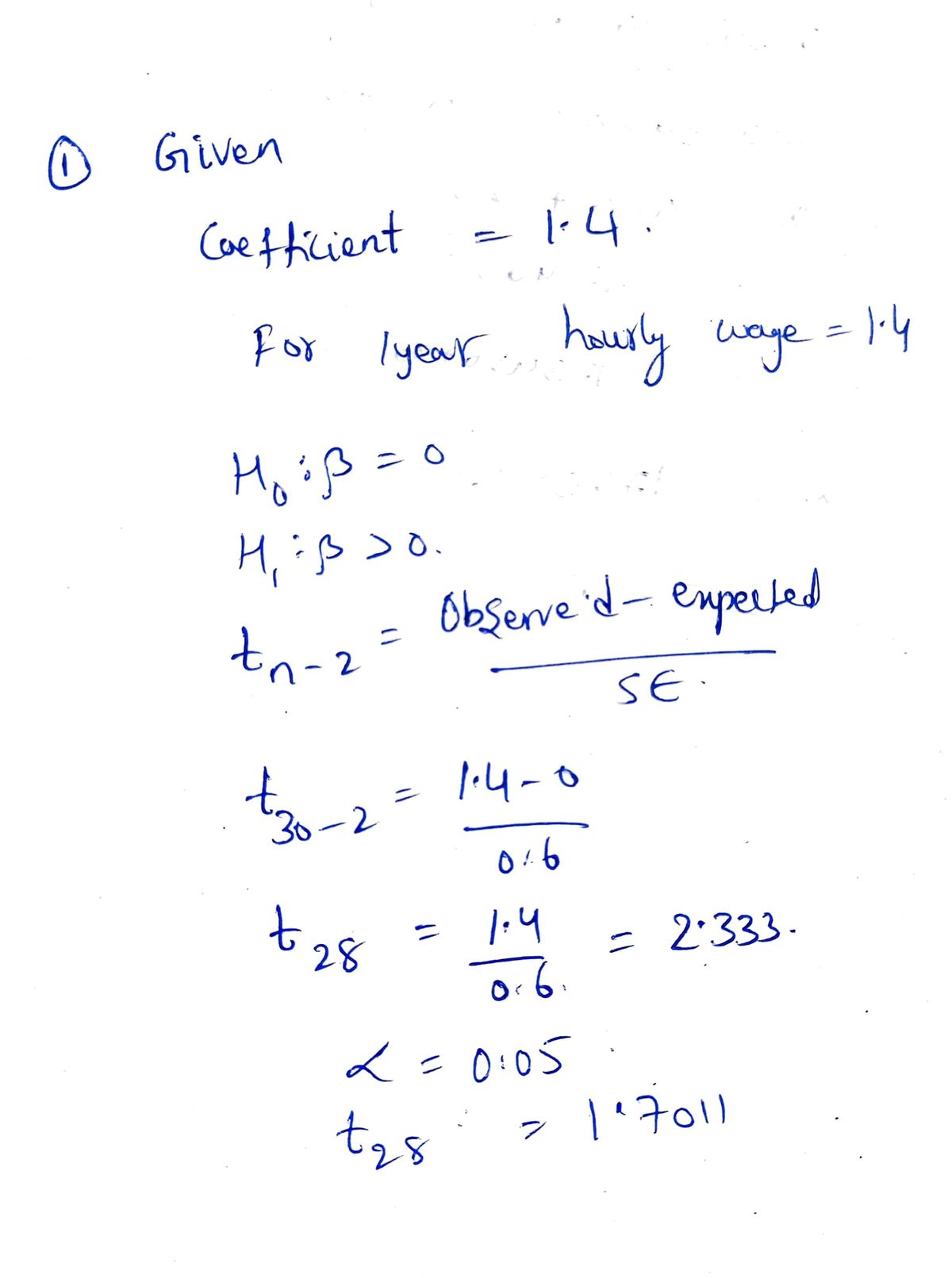Problem 1: The regression below relates earnings to years of experience for a sample of 30 working adults. wage = 15.6 +1.4*exp Predictor Constant Exp Coef 15.6 1.40 SE Coef 2.38 .60 T 6.55 2.33 where wage equals hourly wage rate ($/hour) and exp equals years of work experience a) According to the above regression results, by how much does a year of experience increase the hourly wage rate? b) For a = .05, test the hypothesis that increases in experience are associated with increases in earnings. Clearly state the null and alternative hypotheses, show all relevant statistics for performing the test, and report the conclusion of your test. c) For a = .05 test the hypothesis that a 1year increase in experience increases the wage rate by more than $1/hour. Clearly state the null and alternative hypotheses, show all relevant statistics for performing the test, and report the conclusion of your test. d) What can you conclude from your answers to parts a-c? How can we explain these differences? e) For the wage regression coefficient, calculate a 95% confidence for its value and in 1 or 2 sentences describe its interpretation.
Problem 1: The regression below relates earnings to years of experience for a sample of 30 working adults. wage = 15.6 +1.4*exp Predictor Constant Exp Coef 15.6 1.40 SE Coef 2.38 .60 T 6.55 2.33 where wage equals hourly wage rate ($/hour) and exp equals years of work experience a) According to the above regression results, by how much does a year of experience increase the hourly wage rate? b) For a = .05, test the hypothesis that increases in experience are associated with increases in earnings. Clearly state the null and alternative hypotheses, show all relevant statistics for performing the test, and report the conclusion of your test. c) For a = .05 test the hypothesis that a 1year increase in experience increases the wage rate by more than $1/hour. Clearly state the null and alternative hypotheses, show all relevant statistics for performing the test, and report the conclusion of your test. d) What can you conclude from your answers to parts a-c? How can we explain these differences? e) For the wage regression coefficient, calculate a 95% confidence for its value and in 1 or 2 sentences describe its interpretation.
MATLAB: An Introduction with Applications
6th Edition
ISBN:9781119256830
Author:Amos Gilat
Publisher:Amos Gilat
Chapter1: Starting With Matlab
Section: Chapter Questions
Problem 1P
Related questions
Question
Answers to questions d) and e) are not present. Please see attached screenshot for the question.

Transcribed Image Text:Problem 1: The regression below relates earnings to years of experience for a sample of 30
working adults.
wage = 15.6 + 1.4*exp
Predictor
Constant
Exp
Coef
15.6
1.40
SE Coef
2.38
.60
T
6.55
2.33
where wage equals hourly wage rate ($/hour) and exp equals years of work experience
a) According to the above regression results, by how much does a year of experience
increase the hourly wage rate?
b) For a = .05, test the hypothesis that increases in experience are associated with increases
in earnings. Clearly state the null and alternative hypotheses, show all relevant statistics
for performing the test, and report the conclusion of your test.
c)
For a = .05 test the hypothesis that a 1year increase in experience increases the wage rate
by more than $1/hour. Clearly state the null and alternative hypotheses, show all relevant
statistics for performing the test, and report the conclusion of your test.
d) What can you conclude from your answers to parts a-c? How can we explain these
differences?
e)
For the wage regression coefficient, calculate a 95% confidence for its value and in 1 or
2 sentences describe its interpretation.
Expert Solution
Step 1

Step by step
Solved in 2 steps with 2 images

Recommended textbooks for you

MATLAB: An Introduction with Applications
Statistics
ISBN:
9781119256830
Author:
Amos Gilat
Publisher:
John Wiley & Sons Inc

Probability and Statistics for Engineering and th…
Statistics
ISBN:
9781305251809
Author:
Jay L. Devore
Publisher:
Cengage Learning

Statistics for The Behavioral Sciences (MindTap C…
Statistics
ISBN:
9781305504912
Author:
Frederick J Gravetter, Larry B. Wallnau
Publisher:
Cengage Learning

MATLAB: An Introduction with Applications
Statistics
ISBN:
9781119256830
Author:
Amos Gilat
Publisher:
John Wiley & Sons Inc

Probability and Statistics for Engineering and th…
Statistics
ISBN:
9781305251809
Author:
Jay L. Devore
Publisher:
Cengage Learning

Statistics for The Behavioral Sciences (MindTap C…
Statistics
ISBN:
9781305504912
Author:
Frederick J Gravetter, Larry B. Wallnau
Publisher:
Cengage Learning

Elementary Statistics: Picturing the World (7th E…
Statistics
ISBN:
9780134683416
Author:
Ron Larson, Betsy Farber
Publisher:
PEARSON

The Basic Practice of Statistics
Statistics
ISBN:
9781319042578
Author:
David S. Moore, William I. Notz, Michael A. Fligner
Publisher:
W. H. Freeman

Introduction to the Practice of Statistics
Statistics
ISBN:
9781319013387
Author:
David S. Moore, George P. McCabe, Bruce A. Craig
Publisher:
W. H. Freeman